
26 minute read
Remembering the Duke of Edinburgh’s award in South
Remembering the Duke of Edinburgh’s award in South Africa
Prince Philip, the Duke of Edinburgh’s funeral took place on Saturday 17th April 2021 at Windsor Castle. Philip, Queen Elizabeth II’s husband of 73 years, at the age of 99, just few months shy of his 100th birthday. Philip is remembered for his work with some 780 charities and organisations, particularly his Duke of Edinburgh Award, which seeks to build confidence and resilience in young people. In South Africa, the award was re-launched as The President’s Award in 1994. And it’s still benefiting young people to this day. For the many young people in Orange Farm, a township 45 kilometres from Johannesburg, there’s not much to do after school. But for members of the Jabulile Arts and Culture Society, the all-female marimba class continues to run. Normally, these music lessons would take place at the nearby Jabulile Secondary School, but because of COVID-19 restrictions, they’re taking place outside a local home. The society, which has been operating for the past 11 years, is part of The President’s Award, an initiative empowering young people between the ages of 14 and 24. The Duke of Edinburgh’s International Award Foundation oversees the award programme in over 130 countries and territories globally, with 18 countries in Africa. The award was re-launched as The President’s Award for Youth Empowerment in 1994 with former President Nelson Mandela as its Founding Patron-In-Chief. Over the past decade, more than 60,000 young people in South Africa have developed themselves through the programme. “It’s an amazing, life-changing, non-formal education programme that empowers young people with various universal skills, such as leadership, teamwork, confidence, being able to adapt to new environments,” says Palesa Matuludi, head of development for the organisation. “All those soft skills that are required that are not necessarily attained in a classroom.” After the marimba, the young girls change into their traditional Zulu dance outfits. They sing, chant, and dance, much to the delight of curious young onlookers. Sinehlanhla Mthethwa has been dancing here for the past six years and has dreams of starting her own group in the future. “I want to take my dance far from here, I want to open my own group and give people the knowledge that I have from dancing,” she says. “It has helped me gain more skills and it saved me from being involved in things such as substance abuse, drug abuse, and alcohol abuse.” Thiert-four-year-old Karen Melaphi is a choreographer, who also teaches the marimba. He’s an alumni and began his involvement with the programme 16 years ago. “I have a passion for transferring skills to young people to develop young kids so that they cannot do wrong things around the street because nowadays, most people are smoking drugs in terms of youth, they are getting pregnant, so I teach them arts and culture, discipline and respect through arts and culture,” he says. Nkateko Mabaso from Alexandra Township is another alumni. She’s been involved with the programme for ten years. She says it has changed her life. “It assisted me with confidence, it has assisted me with gaining strength, physical strength, because I had to do the physical journey, just like everybody else, and it didn’t limit me,” she says. “I always thought positively, and that’s why I’m still involved because I can see that it wasn’t just about getting the certificate and badge, but it was about the life skills and being equipped to be the person that I am today.” “As an organization, we are quite saddened by the loss of his Royal Highness, but we also, celebrate the life and the hope that he gives to millions of young people across the globe and in South Africa through the support of the International Award Foundation that oversees the work of the award in over 130 countries around the world,” says Matuludi. As the sun sets, there’s a small crowd gathering outside the home where the marimba and dance classes have just finished. Young men, dressed in orange and white outfits, are ready to showcase their latest Pantsula dance moves. Traffic is brought to a standstill for an impromptu concert. They hope it might inspire other young people to join in the fun.
Advertisement
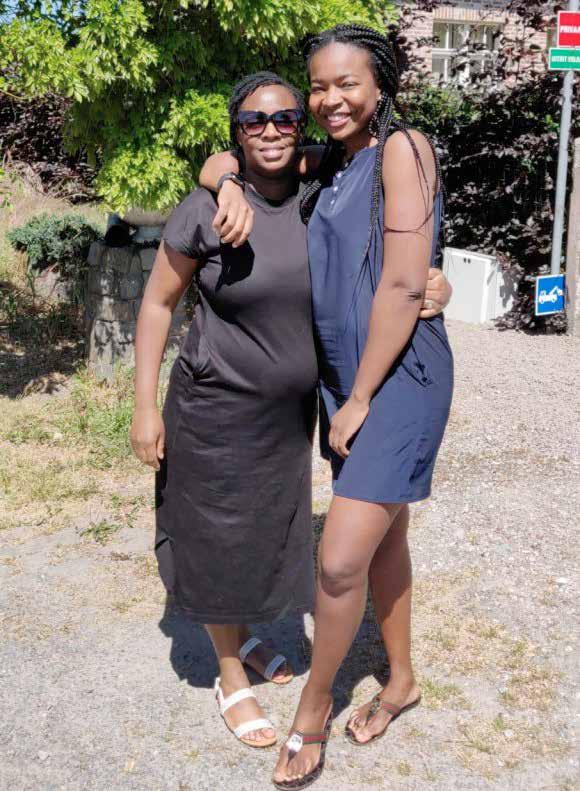
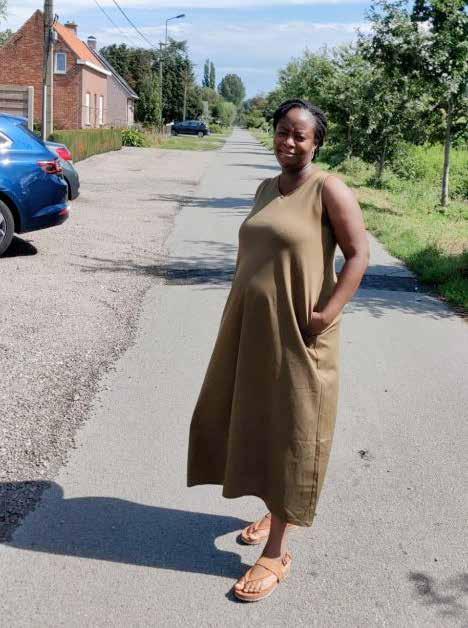
Susan (Left) during the pregancy with her sister-in-law Susan Ogbole hale & healthy during the pregancy on her feet
When a surgery went wrong at Belgian hospital AZ Sint-Jan, Ajima Ogbole’s desire to birth a child was thwarted, prompting her sister-in-law to act as a surrogate. But Susan Ogbole, the surrogate, became crippled after giving birth at the same hospital. With one unable to ever carry a pregnancy and the other potentially unable to ever walk again, the Nigerians are tossed around in Belgium, the hospital unwilling to take responsibility for the traumatic, lifedefining alterations to their lives. This story seem from a movie script but it is a true life experience and ordeal two families are going through right now in Belgium and they are appealing for worldwide concern and attention to their plight. Hours after the surgery to remove fibroid from Ajima Ogbole’s uterus was completed at the Obstetrics and Gynecology unit of AZ Sint-Jan Hospital in Bruges, Belgium, she woke up believing that the obstacle she was told could prevent her from having a child had been surmounted. But she was wrong; her cervix was amputated during the surgery. Problem compounded. In early 2017, she had been diagnosed with uterine fibroid by doctors in Belgium. According to Ajima’s medical report, translated from Dutch, a Magnetic Resonance Imaging (MRI) scan confirmed the presence of multiple subserosal fibroids – grows around the uterus. It is “without signs of complications”, the report stated. Before Dr. Van de Vijver performed the surgery to extract the fibroid in November 2017, Ajima was prescribed medications to reduce the size of the fibroids. The surgery was successful; about 13 fibroids were removed.
THE TRAUMATIC POST-RECOVERY JOURNEY
During a post-surgery checkup in January 2018, an MRI scan was done, but the cervix, a tiny passageway linking the uterus to the vagina, was not found. “I checked and I think it is blocked. We’ll need to put an Intrauterine Device (IUD) to keep the hole open,” Ajima said, recalling what the Belgian doctor told her. But when she returned to the hospital few weeks later, expecting to have an IUD insertion, Dr. Van de Vijver, without prior notification, performed laparoscopy, a diagnostic medical procedure to
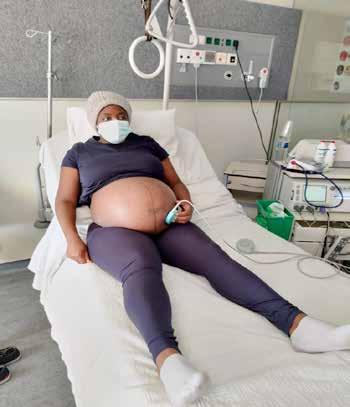
This is Susan before she was delivered, everything seem okay with her
examine internal organs such as the uterus and the cervix. She was deceived; her right as a patient to not receive treatment she did not give informed consent to was breached! “They put me under anesthesia and when I woke up, I had four holes on my tummy, which was a laparoscopy and I didn’t know at the time,” she told the press. “I remember asking my husband if IUDs were usually sewn on the skin and from inside of the uterus. For me, it was strange.”
THE FRUITLESS SEARCH FOR HER CERVIX
She did not know the complexity of her situation when the doctor informed her that her cervix could not be found. Medical report described her cervix as “sharply altered”. Ajima was subsequently referred to a professor of Gynaecology at UZ Leuven, an academic hospital, who could re-create her cervix. At UZ Leuven, before agreeing to help her, the professor said he would take her off the medication Dr. Van de Vijver had placed her on to cease menstruation. The professor thought it was strange that the doctor kept her on the medication after the surgery, Ajima said. About five weeks later, she had her period in severe pain and blood did not flow out of her vagina — it flowed backward. The professor told her that the retrograde menstruation puts her at risk of endometriosis (which causes pelvic pain) and slim chances of cancer if her body continues to absorb the ‘bad blood’. She was given two options: continue taking medications to hold off her period or remove her uterus. The professor then examined her reproductive system with a medical device hoping to find a bubble, which would mean that there was a connection between the vagina and the uterus. But he did not find it. The complexity of the situation became clear when Ajima and her Belgian husband talked to the professor. “What the doctor asked me to do can never be done,” she recalled in tears. “A cervix has never been successfully recreated medically.” Even if one was re-created, there were risks: when pregnancy becomes heavy, there could be a tear. Or there could be other complications, including infections. He warned her to not allow anyone cut her open; as such efforts would be “trial and error”. ‘YOU CAN’T GET PREGNANT AGAIN’
“In fact, he said I couldn’t get pregnant naturally or artificially because the connection between my cervix and my vagina was gone and that my best option was surrogacy,” she said.
Ajima returned home that day, switched off her phones for
After delivery, the baby is okay except for the mother with pains and yet they did nothing to assist her
three weeks and wept. “I never believed that this was what my life had turned into. I knew I wanted kids more than I wanted to get married. The possibility of becoming a mother had been taken away from me,” she lamented.

Together with her husband, she travelled to Nigeria to be with her family. While in the country, she sought opinions from two experts in Abuja and Plateau State. Both told her to forget about getting pregnant.
MENSTRUAL HAPPINESS
After six months of waiting, another professor of Gynaecology who specialises in reconstructive surgery at the University of Ghent performed a laparotomy used to diagnose or treat abdominal health conditions on her. But it was unsuccessful. Ajima had been told the chance of success was slim however she still tried. “By chance of success, he (professor) didn’t mean to get pregnant, he meant to successfully re-create the hole that connects to the vagina first so that I can at least have my period and then try to see if they can help me get pregnant. So, when I was told that it was not successful, I could not cry; Susan being helped out of her bed because she could no longer use her legs, I was just numb.” not able to stand on her feet again for over a year now Two weeks later, she decided to take up the professor’s offer to try Although commercial surrogacy is not illegal, it is in a another reconstructive surgery. After the procedure, she legal grey zone area; there is no law that protects parties had her period. “I never knew I would be so happy to see involved if issues such as filiation and nationality occur. my period again,” she said. Also, hospitals regulate themselves, consequently Her period flowed for three months and then it gradually possessing the freedom to arbitrarily decide whom to take stopped and began spotting (A period is spotting when on as surrogacy candidates. The best option for Ajima there is hormonal fluctuation and bleeding is lighter than and her husband was the United States, but it was too a normal flow). expensive for them after all the spending on medications FOUR SURGERIES IN TWO YEARS and medical bills. The four surgeries she had within two years still cause a A glint of hope came when Susan, the wife of Ajima’s lot of discomfort to her entire being. She said: “At a point, younger brother and a mother of two children aged three I recovered physically but internally, I still feel pains. and five who was moving to Belgium to study at the Free I am not in a good place mentally, psychological and University of Brussels, agreed to be a surrogate for the emotionally. I can’t fully perform my matrimonial duties couple. Susan’s husband consented. as I am always pained, bruised or with blood.” But their perfect plan was set back when hospitals in Ajima’s career as an architect, fashion designer and Belgium, including the one where the cervix error was entrepreneur has also suffered greatly. Her plan was to made, would not accept Susan as a surrogate. Ajima said shuttle between Belgium and Nigeria because of her that they were worried for the safety of the child whose business, but surgeries and constant visits to hospitals nationality at birth would also be Nigerian. have made that impossible. They had to travel to Nigeria for the IVF treatment, In Belgium, having a child through a surrogate is not easy. including embryo creation and implanting in Susan. It was

successful, so they returned to Belgium. Everything went “When this resident was giving her, the ombudsperson in the smoothly except that during the first trimester, she was ill hospital said that the supervisor told her she was there but was many times. not putting on gloves. She just stood aside. It is like giving a FROM CHILDBIRTH TO PARALYSIS resident a heart surgery to do and you are standing there and After birthing a healthy baby at AZ Sint-Jan Hospital on watching; any little thing can ruin somebody’s life,” she said. the morning of October 15, 2020, Susan lost control of both When her epidural was taken out after she gave birth, legs. The family was traumatised and abandoned by the same Susan could not stand without being supported. “I can’t hospital where Ajima’s cervix was mistakenly amputated. feel my legs,” Ajima remembered Susan crying out. The Susan made two requests during one of her visits to the doctor anaesthesiologists and neurologists found nothing. By the before the baby was born: a caesarean delivery and a general third day, Susan could not feel anything from her waist down. anaesthesia – a medication that would make her unconscious. She had become paralysed. She had always been scared of an epidural. ‘AFRICAN BACTERIA’ — THE ‘CONSPIRACY’ TO The Belgian COVER-UP A MEDICAL doctors agreed to a ERROR caesarean section, Susan’s medical report, seen but advised her by the FIJ, described the to choose an pregnancy as uncomplicated epidural because but medical staff described her they wanted the situation after giving birth as a baby to be awake complication. Family members when she was are accusing the hospital born or she would of covering up the medical be taken to the error that resulted to Susan’s neonatal intensive paralysis. “They claimed care unit. Susan it was an African bacterial agreed reluctantly. infection because they don’t Her medical have that particular bacterium report showed in Europe,” Ajima said. “It that she was didn’t make sense because given a combined Susan had been in Belgium for spinal epidural about a year. To cover what anaesthesia — they did, they pumped her with local anaesthetic antibiotics but she is still unable is injected near a to walk. They could not even spinal cord and provide the name of the African nerve roots to bacteria.” block pain from She said a US-based an entire region of anaesthesiologist told her that the body such as if it was a bacterium, it shows the belly, the hips Susan visited by her husband, allowed just one month negligence because it suggests and the pelvis. visa by Belgian Embassy in Nigeria that either the equipment or Ajima said that her mother, her back, where the epidural went who is a nurse and midwife, through, was not properly sterilised. discouraged Susan from taking epidural, as there could Suspicious of the Belgium hospital, the family sought second be problems if improperly done. One of the problems is opinion from a retired professor of anaesthesiology. temporary or permanent nerve damage, which may be caused “If it was a bacterium infection, Susan would have gone by direct damage to the spinal cord, infection in the area near into coma, would have had high fever and would have been the spinal cord or accidentally injecting the wrong medicine hallucinating,” Ajima recalled the retired professor writing in the epidural catheter. in an email. Susan cried and writhed in pains during the epidural Despite disagreeing with the hospital’s diagnosis that Susan procedure, as Dr. Van Laere Freya, an anaesthesiologist who became paralysed because of a bacterium infection, the was supervised by Dr. Geertrui Delrue, prepared her for professor was silent on the question about whether a nerve surgery. Ajima told FIJ that Susan was given the anaesthesia was hit. In fact, he told the family that he would not grant a by a resident in anaesthesiology. request to give an opinion if the issue goes to the court.

Mrs. Susan Ogbole is now permanently on a wheel chair needing assistance to do anything and yet no support from the Belgian authorities
Susan’s family disagrees with some details in her obstetric Before Susan’s transfer to the hospital at the University report by AZ Sint-Jan Hospital. The claim that Susan had of Ghent, AZ Sint-Jan ran some tests and reported on the postpartum fever was denied. “The doctors used claims of evening of December 18, 2020 that she had Covid-19. She fever as a pretext to pump antibacterial into her system in was moved to the coronavirus floor. Susan’s family felt it order to cover up what they did wrong,” Ajima claimed. was a plot to infect her with the disease because two previous GRAM STAIN TEST REVEALS THERE WAS NO tests done within 10 days came back negative. After pressure BACTERIAL INFECTION from her family, she was transferred to Ghent. The report revealed that she was given two antibacterial PARALYSED, THEN DENIED FAMILY SUPPORT BY medications and one antiviral medication. “But even if it’s a BELGIAN AUTHORITIES bacterium, as she’s been pumped with antibiotics for more Since Susan’s childbirth process went wrong, Ajima, who than two weeks, Susan should be on her feet now, four months still experiences aches from the four surgeries she has had after,” she said. Also, a gram stain test done on the fluid in less than two years, had been left with caring for the baby from her spinal cord, post-birth, showed that no bacterium and providing support for her sister-in-law. Her mother-inwas present. The law would have come anaesthesiologists to help; two children who operated on who had not seen their Susan stopped mother for over a year checking on her would have visited but after the family the Belgian government raised concerns to denied them visas. Ajima the hospital, FIJ was said the reason was told. They claimed concerns that they might that because they not leave Belgium, as had been accused they had applied for of racism and family reunion. causing Susan’s However, Susan’s paralysis, attending husband was issued a to her would be an one-month visa instead admission of guilt, of the one year multipleAjima said. entry visa he applied for Dr. Van de Vijver, to enable him visit his the gynaecologist wife as many times as who made Ajima’s possible. In a mail, the medical error and country’s ministry of operated on Susan, interior told the family later distanced that the one-month visa himself from the issued was a “favour”. A family. Susan’s letter from the hospital family believes that stating that Susan would he was instructed to need support from her stop seeing them. family was brushed “It was the closest aside. hospital to us,” The Kingdom of Ajima said when Belgium’s Foreign asked why they Affairs, through its returned to the same Advisor, Barbaix hospital after what Kristiaan, citing privacy happened to her. “And reasons, did not tell FIJ why we did not believe that a the Ogboles were denied mistake would happen again because the doctor who made visas. The Belgian Embassy in Nigeria gave the same reason the mistake asked to be given another chance.” for not answering questions from FIJ. Ajima said that some staff of AZ Sint-Jan said they were SURGEON ASKS BEDRIDDEN SUSAN TO ‘COME TO sure that the medical team that operated on her sister-in-law MY OFFICE’ made an error and they were doing everything to cover it. The hospital did not give the Ogboles an official explanation

for the fatal results of the treatment of two members of a family. Instead, it directed them to talk to its insurance firm. Ethias, the hospital’s insurer, assigned Dr. Goegebuer, an orthopaedic surgeon, to evaluate Ajima’s gynaecology case and Susan’s suspected anaesthesiology and neurology situation. Dr. Goegebuer asked Ajima whether she had a cervix before the surgery, if she was in the country legally and what she did for a living in Belgium. The initial conclusion that the amputation of her cervix was a complication was later

reviewed to medical error after Ajima contended it. However, negotiation for compensation continues to drag on, as both parties could not agree on a fee. In a letter to Susan, seen by this magazine, Dr. Goegebuer instructed her to come to his office to “hear your story and to determine the physical damage”. But her lawyer, in response, said that the doctor did not review Susan’s file because if he did, he would have known that she was immobile. “Since December, when he said he would go to the hospital to meet her, he has not gone. Our lawyer wrote him three times, but he did not respond,” Ajima said. WHY AN EPIDURAL CAN GO WRONG When FIJ contacted Meysmans Saartje of Ethias, he said the firm does not comment on medical treatments. “This is forbidden in respect to privacy,” he explained. However, a medical expert who did not want to be named told FIJ that the removal of subserosal fibroid is not difficult. “So, for the cervix to be cut during the surgery, that worries me,” he said. “However, it depends on the location of the fibroid. It is possible that it happened while the doctor was removing the fibroids close to the cervix.” He noted that Dr. Van de Vijver went against the ‘universal law’ of the profession when he performed a surgical procedure on Ajima without informing her of details such as what would be done and why. “You are not supposed to cry and complain of pains during an epidural. It means the needle went amiss,” the expert said about Susan’s reaction to the procedure. “The skin is usually anaesthetised so that as the epidural is done, there won’t be pain.” He agreed that something was not right with the epidural anaesthesia she was given, but noted that the tiny epidural needle, even if it hits a nerve, “will be transiently traumatised and the nerve will recover”. “It is not supposed to paralyse a person for a long time,” he added. The medical expert explained that surgeries, even those that are seemingly not risky, could go wrong at any time and that allegations of negligence would require in-depth investigations. But no investigation will occur with the hospital and its insurer ignoring the family. “In a medical process, you may do harm while trying to do good; it is not intentional. When issues like this happen, we can only hope that people will speak the truth and live up to the scrutiny of their good conscience if they have anything like that,” he concluded. NOT THE FIRST TIME There are many cases of life-altering medical errors in Belgium. Most times, victims do not get justice because medical workers are treated like ‘demigods’ who cannot be questioned. The country’s health system is structured such that medical workers are shielded from being held responsible for errors that occur while performing their jobs. Left unprotected, medical error victims bear the brunt of this system. The system gives medical workers the impression that even when they do tawdry jobs, they will get away with it. And they do get away. FIJ got reports of two other people who are victims of medical errors in Belgium. In one case, a woman who was given an injection became paralysed; she subsequently died. In the other, a woman’s legs were mistakenly amputated at a hospital in Bruges. The woman is currently seeking other victims of medical error to fight alongside her because on her own, she cannot afford the legal costs, with Belgium’s health system positioned to protect medical personnel from being held accountable for on-the-job errors. AJIMA OGBOLE’S DEMANDS Ajima wants Susan, who can’t travel, to be reunited with her family in Belgium because of her condition and medical attention she requires now to live. She also wants the hospital to apologise and take full responsibility for the fatal results of the treatments she and her sister-in-law had. And she wants the Belgian health system to be overhauled to protect other patients. “If it happened to two family members in the same hospital, then we are hundred percent positive that it’s not just us,” she said. “It’s not just about us, but people coming after us as well as the people before us who didn’t get the justice they deserved.” The family needs your support to continue to protest their case and treatment until they get the right justice deserves in this case. Courtesy of Foundation for Investigative Journalism By Adeola Oladipupo To make personal contact with Ajima Ogbole Spittael & Susan Ogbole Tel. No: +32 468 20 75 47 justice4ajima.susan@gmail.com
Akon City 2: Akon Unveils Plan to Build Second Futuristic Cryptocurrency City in Uganda
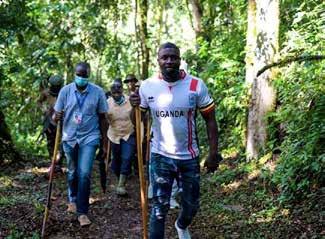
Another futuristic harness resources and cryptocurrency city investments, attract investors, will be built in Africa, manage the project, and have Senegalese-American star a city. Akon has announced. The According to local media, government of Uganda will the new crypto city will use make land available to him Akon’s own cryptocurrency, for the construction of the the stellar-based akoin, similar new crypto city. The akoin to how it is planned for in cryptocurrency will be used in Senegal’s Akon City. the city, similar to how it will The Akoin cryptocurrency is be in Akon City, the $6 billion already being used in Mwale “real-life Wakanda” that is Medical and Technology City currently being constructed in Akon’s home country. (MMTC) in Kenya as a pilot for Akon City. “We’re going SECOND AKON CITY TO LAUNCH IN UGANDA to use exclusively akoin by the end of 2021,” Julius Mwale, Senegalese-American star and philanthropist Akon, whose the principal investor of MMTC, said in November last year. real name is Alioune Badara Thiam, announced last week When Akon was asked about whether Ugandans will be his plan to build a second futuristic cryptocurrency “My true calling is to develop Africa, able to afford to live in the futuristic Akon city in Africa. Its home will whatever it takes.” - Akon City, the singer replied: be in Uganda. “I know if I put it there, His first crypto city, Akon they’re going to find City, which costs $6 billion, is being built in his native a way to afford it because it’s going to motivate them … country of Senegal. Akon described it as a “real-life Ultimately, when you create an opportunity, people grow Wakanda,” comparing Akon City to the technologically with that opportunity, people learn with that opportunity, advanced fictional African city in the blockbuster movie people are motivated with that opportunity.” Black Panther. Akon also shared his bigger vision, emphasizing that “the Akon’s new cryptocurrency city has the backing of the continent is our goal.” The singer elaborated, “To build the Ugandan government. Isaac Musumba, Uganda’s Minister continent, we need to unite as a people to make this thing of State for Lands, Housing, and Urban Development, said happen,” adding: at a press conference last week that the government will find My true calling is to develop Africa, whatever it takes. suitable land of one square mile or larger for Akon to build As for the crypto city in Uganda, he noted that “The idea is the new crypto city. The minister elaborated: to utilize all the resources that we built throughout the years A place suitable in Uganda that has not-less-than one square and try to rebuild the country.” mile will be made available to him and his team so he can Specifically, he detailed: “We will be having some professionals that we plan to fly into Uganda that can train the locals and I think one of the things that we miss out in major countries is the access of information and we need to be properly trained not only just in construction but also the management of the property and then the maintenance of the properties.” The construction of the crypto city in Uganda is scheduled to be completed in 2036. Akon concluded: We’re hoping that everything works the way it’s supposed to work but as we move forward with all the support necessary, I think this is a very achievable goal. By Titus Seruga
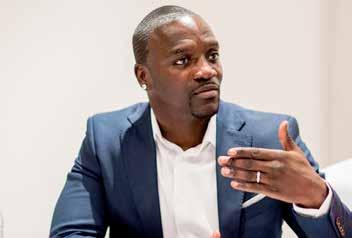

Akon receives a good reception in Uganda over his dream city for Uganda
President Museveni has said his government will identify land to enable Senegalese-American musician Aliaune Damala Badara Thiam alias Akon to set up investments in Uganda. Akon and his wife Rozina Negusei who were on a four-day visit to Uganda last month visited the president and the First Lady, Janet Museveni at their country home in Rwakitura. According to a statement from State House, the president had a fruitful meeting with the Senegalese singer, cum investor as they discussed a number of investment opportunities in Uganda. “During the meeting at the president’s countryside home Rwakitura in Kiruhura district, attended by the First Lady Janet Museveni and the Minister of Education and Sports, the president shared with guests many areas of interest and value of the untapped natural resources for investment in the country; many of them with rare natural scenery on the globe,” the statement said. “The president told the investor that to put investment interests in motion in a short period, government would spot land for him preferably in central region districts or Kalangala district islands.” Musician cum entrepreneur, Aliaune Akon Thiam alias Akon completed his two-day excursion in which he interfaced with the Pearl of Africa has to offer in terms of natural endowment. Having first visited Queen Elizabeth National Park, Akon together with wife, Rozina Negusei completed the excursion with a visit to the Bwindi Impenetrable forest national park, known for gorillas. Donning Uganda Cranes jerseys, Akon and wife enjoyed the tracking but were on several occasions seen panting, courtesy of the jungles they went through. Despite hiking on a muddy day, Akon was amazed by the rare opportunity he got to get an up-close and personal shot with the Gorillas, he excitedly referred to himself as “the papa of Gorillas” after his wife Rozina Negussei wished she could adopt the baby Gorilla she had seen. By Titus Seruga
















